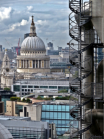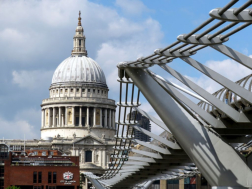





Docklands and the Thames,
Victoria Park to Paternoster
Square. Take a nostalgic
trip back to the East End in
the 1950’s or a stroll around
the Square Mile of the City
of London. It’s all here at
barryoneoff.co.uk
Copyright 2002 - 2024 ©Barry Carter. All rights reserved
SAINT PAULS CATHEDRAL
Wren’s Masterpiece
The Great fire of London in 1666 destroyed 89 churches within the City. Many of those to be rebuilt during the following years were designed by the office of Sir Christopher Wren, and Saint Paul’s was to be his most famous. The one building that most people remember him for is still an imposing sight even by today’s standards. It’s great dome is an unmistakable feature of the City of London skyline and planners of new developments are required to leave certain sight lines unimpeded when designing new structures to be built. There has been a cathedral church on this site from ancient times. The present one has stood here since the final stone was laid at the beginning of the eighteenth century. A cathedral dedicated to Saint Paul was founded by Bishop of London, Mellitus, during the reign of King Ethelbert around the year 604 AD. There have been at least four built on the same site. Two of the churches suffered the same fate of being destroyed by fire. The present building, finished in 1710, took 35 years to complete although services were held there years before it was finally finished. Wren, then in his eighties, was hoisted up in a basket to lay the final stone himself!The Early Years
The first bishop of the East Saxons, Mellitus, took charge of the small wooden church built on this site in the year 604 and that building lasted for 70 years before being destroyed by fire. The bishop of that time, St. Erkenwald spent ten years building it's replacement from 675 to 685. This, the second Saint Paul's was destroyed by invading Vikings in the year 962 AD. and another constructed. That church was also destroyed by fire in 1087, which led to the building of the old St. Pauls. The cathedral saw many changes in the years leading up to the 1666 fire, from attack and rampaging by mobs spurred on by over zealous Protestant preachers, to merchants turning it into a market place for their wares. It was even used as a barracks by Cromwell’s soldiers during the Civil War.Old St. Pauls
The previous cathedral is referred to as Old St. Pauls and was built mainly by the Normans. It was a large impressive building with a 489 ft. spire. Building was started in 1087 after fire destroyed the previously existing church. This one took 150 years to fully complete, although the spire came some years later, and wasn’t completed until the year 1314. In 1561 the tall spire was struck by lightening and destroyed. The rest of the building remained intact and the spire was never replaced. This cathedral was totally destroyed in the Great Fire of London in 1666. Ironically Wren was doing some repair work on the church at the time, and it was his wooden scaffold that fed the flames and help destroy it.St. Pauls of Today
The Saint Pauls Cathedral we see today is basically the same building that took 35 years to build more than three centuries ago. Additions and alterations have been carried out over the years but the basic structure and layout remain the same. Even the original organ, installed in 1695 is still in use. One of the most recent significant additions are the mosaics which were installed after Queen Victoria commented on how dingy the décor was. A second altar has also been added to enable the congregation to be nearer the services.The Dome. More Than
Meets The Eye.
Look at the Dome of Saint Pauls from the outside. You may think you are looking at the same ornate dome you look up to on the inside of the church. You are not, it's an illusion. They are totally different size domes. Look carefully at the dome from the street. Notice how tall it is. Could this really hold the artwork painted on the inside? No, it would be almost at right angles around the sides, wouldn’t it? From the inside, looking up, it is more like a deep smooth saucer shape. So how can this be? Is it an optical illusion? Wren was a very clever man. He designed it to look like there is one dome but there are actually three. Click the picture and all will be revealed. There is a shallower unsupported dome, the one you see when you look up to the ceiling, bearing the paintings. Above this there is a hidden cone shaped brick dome. This second dome supports the exterior dome with wooden beams coming from it. It is thought that when Wren was rebuilding St. Stephen Walbrook he was experimenting; trying out the idea for the future dome of St. Pauls.






















